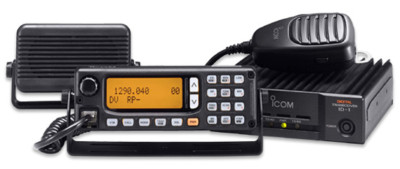
UHF Repeaters
The Icom IC-ID1 1.2 GHz transceiver is a vital part of a D-STAR
system, you won’t have to wait for a new repeater to be set-up in your area.
This rugged little rig operates with current analog 1.2GHz repeaters, plus
simplex digital operation with another ID-1.
Its operating frequency range is
1240-1300 MHz, with FM and GMSK (Digital) modulation formats. The ID-1 includes
all the usual features that you expect - 105 alphanumeric memory channels, PLUS
full PC control via the USB port (a black box 1.2 GHz radio!). Now for the fun
part ... the ID-1 supports a 10BASE-T Ethernet cable for the 128K DATA
operation! Both the USB and Ethernet connections are on the back panel.
Explore the benefits of wireless high-speed integrated digital connections!
Power can be set for 1 or 10 watts and tuning steps are: 5/6.25/10/12.5/20/25/50/100 kHz.
________________________________
With Digital Voice & High Speed Data
![]()
What is D-STAR?
D-STAR is a new ham radio system which offers digital voice and data communication. It connects repeater sites over microwave links and the Internet and forms a wide area ham radio network. The DSTAR system provides a new capability and functionality to the ham radio world and increases the efficiency of emergency communications.
What can the D-STAR system do?
128kbps digital data and 4.8kbps digital voice communication
The D-STAR system provides not only digital voice (DV mode) communication but also digital data transmission (DD mode). It can exchange various data files such as graphics, images, etc, at 128kbps.
Your voice and data can reach further than ever
Multiple repeater links by radio and the Internet provide long distance communication to virtually anywhere.
Internet application available
The D-STAR system uses the TCP/IP protocol, so when connected with a PC, web, e-mail and other Internet applications are available.
Wireless Internet Access
No matter where you travel within the DSTAR network, you can access the web, e-mail, text messages and multimedia messages.
Independent network
In DD mode, ID-1 can transfer data directly with another ID-1 without the use of a repeater. This is useful for establishing a simple network where a D-STAR repeater does not exist or D-STAR services are not required.
Increase efficiency of emergency communications
Out in the field, fast emergency information is the key. Send pictures and weather charts to or from a remote location with the ID-1. “A picture is worth a thousand words”, and efficient send/receive opens up your repeater for other emergency communications.
PC remote controller supplied
 The controller software is supplied with the ID-1. When the ID-1 is connected to a PC via a USB cable, most functions of the ID-1 can be controlled from the PC. In DD mode operation*, you can browse web sites and send and receive e-mail as if the ID-1 is a 10W wireless network adapter.
The controller software is supplied with the ID-1. When the ID-1 is connected to a PC via a USB cable, most functions of the ID-1 can be controlled from the PC. In DD mode operation*, you can browse web sites and send and receive e-mail as if the ID-1 is a 10W wireless network adapter.
* Ethernet port is required for DD mode operation.

 Useful callsign functions
Useful callsign functions
The ID-1 embeds your own and the called station’s callsign in your transmission. When you input “CQCQCQ” as the intended station, you can make a CQ call in the area. The calling station’s ID is displayed on the received station and a newly received callsign can be automatically stored in the memory.
Digital callsign squelch (DSQL) & Digital code squelch (CSQL)
The DSQL opens the squelch, only when your callsign is received. When you share a single callsign with a club or group members, the CSQL function allows you to set a CSQL code from 00 to 99 and provides quiet stand-by while other members are talking.
EMR mode operation
When you require the attention of all stations in the area, the Enhanced Monitor Request (EMR) mode operation allows the caller to bypass the CSQL and DSQL setting of the receivers station. During EMR mode operation, all receiving stations will hear your audio, even though they may be muted.
Short message in DV mode
Short messages of 20 characters max. can be sent in DV mode operation.
Analog FM mode operation
The ID-1 also operates in analog FM mode, allowing you to communicate with an analog FM transceiver. In FM mode operation, the ID-1 has CTCSS tone squelch and pocket beep functions for quiet stand-by.
Other features
- 950bps (approx.) data communication capability in DV mode
- AFC (Automatic Frequency Control) function*
- S-meter squelch
- Break-in communication
- Programmed, memory and select mode scan
- Stand-by beep
* FM and digital voice only.
Rear View

D-STAR repeater system
The D-STAR repeater is composed of a repeater controller, 1.2GHz digital voice repeater, digital data repeater, 10GHz microwave relay and the Internet gateway PC. For the signal is digital data, no information is lost due to conversion and multiple repeater relays are possible in this system. The D-STAR system repeater can perform 3 relay functions as shown in the following figures.
Single repeater
The D-STAR repeater operates similar to existing analog repeater. That is a simple relay of transmit and receive communication in 1.2GHz band.

Microwave link
When D-STAR repeaters are connected via 10GHz microwave, the D-STAR system transfers a received data to another repeater site. You can also make a CQ call to a specified repeater area.

Internet gateway relay
When D-STAR repeaters are connected with the Internet gateway, the D-STAR system relays the received data over the Internet. Microwave links and Internet gateways can be combined even during one contact. So your message will get through virtually to anywhere in the D-STAR system.


